Publications

October 28, 2014
In 2013, Carsey released a brief that analyzed rates of restraint and seclusion using a large, nationally representative data set of U.S. school districts. This brief, which analyzes a more comprehensive data set and the most current Civil Rights Data Collection, serves as a follow-up to the previous brief.

October 21, 2014
While much of the existing research explores young adults' insurance only in the post-recession period (that is, 2010 to present), authors Michael Staley and Jessica Carson assess young adults' rates of coverage within and beyond the context of the recession by examining changes across the entire 2007 to 2012 period.
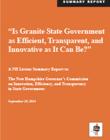
September 25, 2014
The New Hampshire Governor’s Commission on Innovation, Efficiency, and Transparency in State Government was established by Governor Hassan in 2013. In June of 2014, the Commission contracted with NH Listens to host conversations around the state with citizens, state employees, and vendors to gather information about ways to improve state government functions, with a particular focus on the…
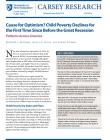
September 19, 2014
New data released on September 18, 2014, by the U.S. Census Bureau indicate that child poverty fell by 0.4 percentage point between 2012 and 2013, to 22.2 percent. Though still significantly higher than in 2007 when the Great Recession hit (18.0 percent), and higher than at its conclusion (20.0 percent) in 2009, the decline from 2012 may be cause for optimism. Estimates suggest the number of poor…
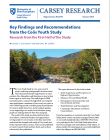
September 3, 2014
In this brief, authors Michael Staunton and Eleanor Jaffee review the key findings and recommendations from research conducted in the first half of the Coös Youth Study, which began in 2008 and is planned to continue through 2018.
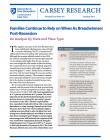
July 29, 2014
This brief presents an analysis of the increased role employed wives played in family economic stability prior to, during, and after the Great Recession, focusing on changes in the contribution of employed wives’ earnings to family earnings by state, region, metropolitan areas, and nonmetro residence.
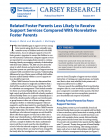
July 15, 2014
This brief identifies gaps in support services among foster parents using data from a nationally representative survey of children involved in the child welfare system (the second National Survey of Child and Adolescent Well-Being).
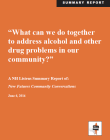
June 30, 2014
In February and March of 2014, residents from across the state of New Hampshire gathered to discuss issues related to substance use and addiction in the Granite State. Fifteen groups met in nine regions of the state including Berlin, Derry, Keene, Laconia, Lebanon, Manchester, Nashua, Rochester, and Portsmouth. In addition, a conversation with business leaders about substance use in New Hampshire…
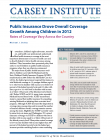
June 17, 2014
Using data from the American Community Survey, this brief examines the rates of health insurance coverage among children under 18 in the United States by region and by rural, suburban, and central city residence between 2008 and 2012.
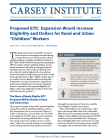
June 3, 2014
This brief uses data from the 2013 Annual Social and Economic Supplement to the Current Population Survey to examine how President Obama’s proposed expanded eligibility and higher credit values might affect tax filers in both rural and urban America.
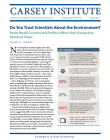
May 20, 2014
In this brief, author Lawrence Hamilton examines the results of a Granite State Poll conducted by the University of New Hampshire Survey Center in late January–early February 2014. The poll asked about public trust in scientists, along with other questions on science, political, and social issues that help to place the science-trust results in perspective.
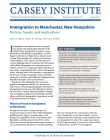
May 6, 2014
This brief analyzes immigration and refugee resettlement in Manchester and the effects on the city’s demographic composition, as well as the implications for its future. Authors Sally Ward, Justin Young, and Curt Grimm report that Manchester, New Hampshire, like the nation, is experiencing a new wave of immigration.
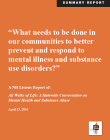
April 23, 2014
On November 14th, 2013, a consortium of organizations and interests sponsored All Walks of Life: A Statewide Conversation on Mental Health and Substance Abuse. Over 300 New Hampshire residents met in six different locations across the state to talk about their priorities, concerns, and ideas regarding mental health and substance abuse in New Hampshire. At the outset, the goals of this…
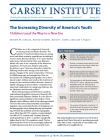
April 22, 2014
This brief documents how unfolding demographic forces have placed today’s children and youth at the forefront of America’s new racial and ethnic diversity. Authors Kenneth M. Johnson, Andrew Schaefer, Daniel T. Lichter, and Luke T.
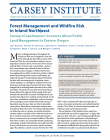
April 8, 2014
This brief reports the results of a mail survey of forest landowners in northeastern Oregon conducted in the fall of 2012 by the Communities and Forests in Oregon (CAFOR) Project at the University of Colorado and the University of New Hampshire in cooperation with Oregon State University College of Forestry Extension.
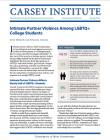
March 25, 2014
Drawing from a survey of 391 college students in same-sex relationships, this brief documents the rates and patterns of intimate partner violence, and responses to it among LGBTQ+ youth.
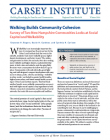
March 11, 2014
This brief reports the results of a survey conducted in 2009 of approximately 2,000 households in Portsmouth and Manchester, New Hampshire, to examine the connection between walkability and social capital.
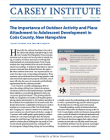
February 11, 2014
This brief discusses the rates of participation in structured and unstructured outdoor activities as Coös County youth age, along with the relationship between outdoor activity involvement and indicators of place attachment throughout this period. The analysis is based on data collected between 2008 and 2013 as part of the Carsey Institute’s Panel Study of Coös County youth.
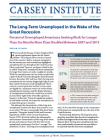
January 22, 2014
Using the Annual Social and Economic Supplement of the Current Population Survey, this brief outlines the demographic and economic characteristics of the long-term unemployed and compares them with their short-term unemployed counterparts. It also describes changes in the composition of the long-term unemployed since the start of the Great Recession.
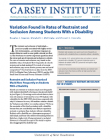
December 17, 2013
The restraint and seclusion of individuals—practices usually associated with highly restrictive environments—are extreme responses to student behavior used in some public schools. In this brief, authors Douglas Gagnon, Marybeth Mattingly, and Vincent Connelly report that restraint and seclusion are used much more frequently on students with a disability than on students without a disability.
